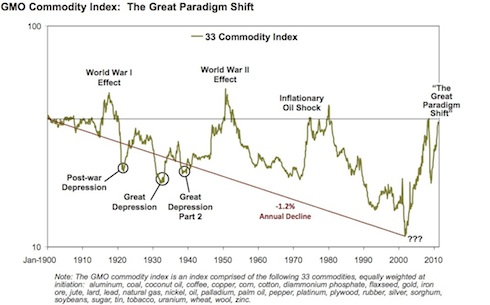Graham’s note: this is an excerpt of a client letter I sent out to subscribers of Private Wealth Advisory regarding the growing threat of inflation in the financial system. Today we assess how population demographics and finite resources will impact the cost of living going forward. To learn more about Private Wealth Advisory, CLICK HERE.
As noted previously, the world’s central banks, while flooding the financial system with liquidity to combat their dreaded debt deflation, have let the inflation genie out of the bottle. However, there is a second, far more important trend that will determine a higher cost of living going forward: that of finite resources vs. an exponentially growing population.
In 1800 there were roughly 800 million people on the planet. Today there is north of seven billion. And according to Mark McLoran of Agro-Terra, the Earth’s population will be growing by 70-80 million people per year going forward.
Against this backdrop of rapid growth, the supply of food is falling. Up until the 1960s, mankind dealt with increased food demand by increasing farmland. However, starting in the ‘60s we began trying to meet demand by increasing yield via fertilizers, irrigation, and better seed. It worked for a while (McLoran notes that between 1975 and 1986 yields for wheat and rice rose 32% and 51% respectively).
However, in the last two decades, these techniques have stopped producing increased yields due to their deleterious effects: you can’t spray fertilizer and irrigate fields ad infinitum without damaging the land, which reduces yields. McLoran points out that from 1970 to 1990, global average aggregate yield grew by 2.2% a year. It has since declined to only 1.1% a year. And it’s expected to fall even further this decade.
Thus, since the ‘60s we’ve added roughly three billion people to the planet. But we’ve actually seen a decrease in food output in terms of yield. And we’re not discovering new farmland to compensate for this. Indeed, worldwide arable land per person has essentially halved from 0.42 hectares per person in 1961 to 0.23 hectares per person in 2002.
The result of this is that we are currently witnessing a tremendous shift in the natural resources space. As asset management firm GMO noted in a recent client letter, a 100-year trend in commodity prices began to shift in 2002.
 This chart and population demographics tell us in no uncertain terms that higher prices will be a reality going forward. Put another way, the days of cheap food and cheap resources is ending.
This chart and population demographics tell us in no uncertain terms that higher prices will be a reality going forward. Put another way, the days of cheap food and cheap resources is ending.
This ties in with one of our dominant themes at Phoenix Capital Research: that inflation will be growing in the coming years. Whether it’s by currency devaluation, supply shocks, or population demographics, the cost of living will be rising in the years to come.
For this reason, long-term investors need to be preparing for inflation now if they are to maintain their purchasing power in the years to come.
To read the rest of this client letter, see the investments I’ve isolated that will maintain their purchasing power during inflation (they’re not Gold and Silver) and learn more about Private Wealth Advisory can help you outperform the market…
Best Regards
Graham Summers




